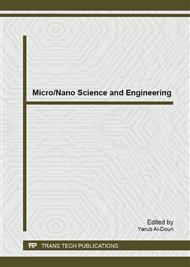p.630
p.635
p.641
p.646
p.651
p.656
p.661
p.669
p.674
Numerical Simulation of Water Flow Velocity for Microfluidic Application Using COMSOL Multiphysics
Abstract:
In microfluidic devices, the most important aspect has to be considered for the manufacturing process is the geometric design. Simulation is a good approach for determining the performance of the design. In this study, several microchannel designs were simulated using COMSOL Multiphysics 4.2 software in order to find the optimized geometry. It involves a study of different shape, diameter, length, and angle of microchannels design, and its influence on the water flow velocity. From the simulation results, an optimize microchannels design was obtained which consists of 100 μm cross-sectional diameter, 4:3:11 channel length ratio, and 35 degrees of microchannels angle. Further study could be done to improve the finding of the microfluidic simulation design for better water flow behavior.
Info:
Periodical:
Pages:
651-655
Citation:
Online since:
April 2014
Price:
Сopyright:
© 2014 Trans Tech Publications Ltd. All Rights Reserved
Share:
Citation:


